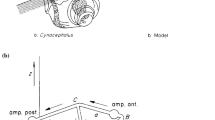Summary
-
1.
Properties of the receptors of single sensory hairs (thread hairs) were studied electrophysiologically in the isolated, opened, canals of the statocyst of the crab,Scylla serrata.
-
2.
Each thread hair is innervated by two receptors which have an opposite directional sensitivity to hair displacements. Most receptors are phasic-tonic, some are purely phasic (Fig. 5). The phasic-tonic receptors have a bell shaped stimulus-response curve (Figs. 6 and 7).
-
3.
The thread hairs can deflect over a wide range. Over parts of this range the receptors are sensitive to displacement, over other parts they are sensitive to velocity (Fig. 8).
-
4.
The effect of gravity on the thread hairs was measured (Fig. 9) and the relationship between the pitch position of the crab and the position of the thread hairs relative to the sensory cushion was calculated (Fig. 11). Taken together with the effect of the hair position on the receptor sensitivity we could infer the phase and gain of the thread-hair receptor output in different pitch positions of the crab (Fig. 12).
-
5.
On the basis of the inferred effects of the position of the crab on the receptor output we could predict particular fluctuations in phase and gain in the eye reflex if the crab were oscillated in different pitch positions. These predictions match with the results of previous behavioral experiments.
-
6.
The properties of the canal receptors of the crab are essentially similar to those of vertebrates.
Similar content being viewed by others
References
Blanks, R.H.I., Estes, M.S., Markham, C.H.: Physiologic characteristics of vestibular first-order canal neurons in the cat. II. Response to constant angular acceleration. J. Neurophysiol.38, 1250–1268 (1976)
Dunn, P.A.: Anatomy and physiology of hair receptors in the statocyst of the crabScylla serrata. Thesis, Australian National University, Canberra (1975)
Fernandez, C., Goldberg, J.M.: Physiology of peripheral neurons innervating semicircular canals of the squirrel monkey. II. Response to sinusoidal stimulation and dynamics of peripheral vestibular system. J. Neurophysiol.34, 661–675 (1971)
Fraser, P.J.: Free hook hair and thread hair input to fibre 5 in the mud crabScylla serrata during antennule rotation. J. comp. Physiol.103, 291–313 (1975)
Goldberg, J.M., Fernandez, C.: Physiology of peripheral neurons innervating semicircular canals of squirrel monkey. I. Resting discharge and response to constant angular accelerations. J. Neurophysiol.34, 635–660 (1971)
Groen, J.J., Lowenstein, O., Vendrik, A.J.H.: The mechanical analysis of the responses from the end-organs of the horizontal semicircular canal in the isolated elasmobranch labyrinth. J. Physiol. (Lond.)117, 329–346 (1952)
Janse, C., Sandeman, D.C.: The rÔle of the fluid-filled balance organs in the induction of phase and gain in the compensatory eye reflex of the crabScylla serrata. J. comp. Physiol.130, 95–100 (1979)
Kolmer, W.: Der Bau der Endapparate des Nervus octavus und deren physiologische Deutung. Ergeb. Physiol.11, 372–416 (1911)
Kubo, T., Matsunaga, T., Matano, S.: Effects of sinusoidal rotational stimulation on the vestibular neurons of rats. Brain Res.88, 543–548 (1975)
Lowenstein, O.E.: Comparative morphology and physiology. In: Handbook of sensory physiology, Vol. VI/1. Kornhuber, H.H. (ed.), pp. 75–120. Berlin, Heidelberg, New York: Springer 1974
Mayne, R.: A systems concept of the vestibular organs. In: Handbook of sensory physiology, Vol. VI/2. Kornhuber, H.H. (ed.), pp. 494–580. Berlin, Heidelberg, New York: Springer 1974
O'Leary, D.P., Dunn, R.F., Honrubia, V.: Analysis of afferent responses from isolated semicircular canal of the guitarfish using rotational acceleration white-noise inputs. I. Correlation of response dynamics with receptor innervation. J. Neurophysiol.39, 631–644 (1976)
O'Leary, D.P., Honrubia, V.: Analysis of different responses from isolated semicircular canal of the guitarfish using rotational acceleration white-noise inputs. II. Estimation of linear system parameters and gain and phase spectra. J. Neurophysiol.39, 645–659 (1976)
Precht, W., Llinás, R., Clarke, M.: Physiological responses of frog vestibular fibers to horizontal angular rotation. Exp. Brain Res.13, 378–407 (1971)
Sandeman, D.C.: Dynamic receptors in the statocysts of crabs. Fortschr. Zool.23, 185–191 (1975)
Sandeman, D.C., Okajima, A.: Statocyst-induced eye movements in the crabScylla serrata. I. The sensory input from the statocyst. J. Exp. Biol.57, 187–204 (1972)
Sandeman, D.C., Okajima, A.: Statocyst-induced eye movements in the crabScylla serrata. II. The responses of the eye muscles. J. Exp. Biol.58, 197–212 (1973)
Silvey, G.E., Dunn, P.A., Sandeman, D.C.: Integration between statocyst sensory neurons and oculomotor neurons in the crabScylla serrata. II. The thread hair sensory receptors. J. comp. Physiol.108, 45–52 (1976)
Silvey, G.E., Sandeman, D.C.: Integration between statocyst sensory neurons and oculomotor neurons in the crabScylla serrata. I. Horizontal compensatory eye movements. J. comp. Physiol.108, 35–43 (1976a)
Silvey, G.E., Sandeman, D.C.: Integration between statocyst sensory neurons and oculomotor neurons in the crabScylla serrata. III. The sensory to motor synapse. J. comp. Physiol.108, 53–65 (1976b)
Wersäll, J., Bagger-Sjöbäck, D.: Morphology of the vestibular sense organ. In: Handbook of sensory physiology, Vol. VI/1. Kornhuber, H.H. (ed.), pp. 123–170. Berlin, Heidelberg, New York: Springer 1974
Author information
Authors and Affiliations
Additional information
C.J. was financially supported by the Free University, Amsterdam and by the I.B.R.O.
Rights and permissions
About this article
Cite this article
Janse, C., Sandeman, D.C. The significance of canal-receptor properties for the induction of phase and gain in the fluid-filled balance organs of the crabScylla serrata . J. Comp. Physiol. 130, 101–111 (1979). https://doi.org/10.1007/BF00611045
Accepted:
Issue Date:
DOI: https://doi.org/10.1007/BF00611045




